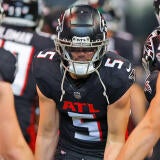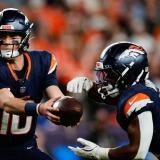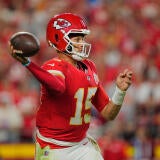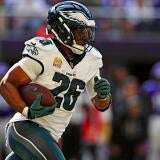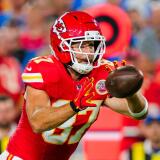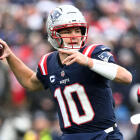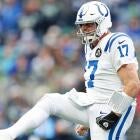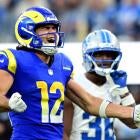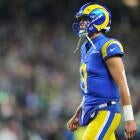Trends from the top 100 NFL players list: Franchise QBs win, franchise RBs don't
As offenses evolved to feature franchise quarterbacks, it lessened the importance of franchise running backs. This point has been made numerous times in recent years and was brought home again when CBSSports.com's Pete Prisco unveiled his list of top 100 players heading into the 2012 season.
By
Ryan Wilson
•
6 min read
 |
| Rodgers topped Pete Prisco's Top 100 players; MJD, meanwhile, was the highest-rated RB at No. 19. (US PRESSWIRE) |
The NFL is a passing league. This explains how three quarterbacks threw for more than 5,000 yards (Drew Brees, Tom Brady, Matthew Stafford) during the 2011 regular season, and how another, Super Bowl champion Eli Manning, was just 67 yards short of that milestone. Previously, it had happened just twice: Brees accomplished the feat in 2008, and Dan Marino originally set the mark in 1984.
| More on NFL: Top 100 |
| Analysis |
 |
| Related links |
|
| NFL coverage on the go |
The theory goes like this: because runnings backs are interchangeable, in general, teams shouldn't draft them in the first round. Unlike quarterback, left tackle, cornerback and defensive end, running backs are easy to replace. It's not unusual for a third- or fourth-rounder to perform as well if not better than their first-round counterparts. That is less common at the other positions mentioned above.
There's also this: the shelf life for running backs is short even in football terms. A study by Doug Drinin of Pro-Football-Reference.com found that running backs usually decline by age 28, which is two years before wide receivers and four years before quarterbacks. It's the nature of a position heavily reliant on brute force with the consequences often involving full-speed collisions.
This isn't an indictment of the quality of the running back in today's NFL, but an economic argument for better allocating limited salary-cap dollars, especially if that means landing the aforementioned franchise QB.
With that in mind, here are the running backs who made Pricso's top 100:
19. Maurice Jones-Drew (2nd round)
28. Adrian Peterson (1st)
32. LeSean McCoy (2nd)
36. Arian Foster (UDFA)
52. Ray Rice (2nd)
63. Matt Forte (2nd)
66. Frank Gore (3rd)
89. Chris Johnson (1st)
96. Michael Turner (5th)
100. Darren Sproles (4th)
Ten running backs, none ranked higher than 19th. Of those ten, only two were first-rounders. Of those two, Peterson may not be his usual dominating self when the season begins because he's coming off a knee injury, and Chris Johnson in 2011 was atrocious after signing a shiny new contract during training camp.
And while Prisco admits that his list is based on opinion, statistical evidence supports his thinking, particularly in terms of where he has running backs ranked compared to other players (more on that in a second). Looking at the rushing leaders (as measured by Football Outsiders' metrics) from 2002-2011, first-rounders are well represented. Also well represented: mid-round selections and undrafted free agents.
Other observations:
* Six times in 10 seasons, the NFL's top back wasn't a first-round pick, and twice he was an undrafted free agent.
* On average, the top backs over the 10-year span were selected between picks 30 (2011) and 132 (2009). (Note: undrafted free agents were assigned pick No. 253 -- give or take a few, 250 players are taken in the NFL Draft.) Looking at the median value, the top backs over that same time frame were selected between picks 13 (2011) and 73 (2009, 2010).
* In 2010, Arian Foster and BenJarvus Green-Ellis ranked second and third in the league in running back efficiency. Both players were undrafted.
Just as beliefs changed about the world being flat, most people now agree with the notion that drafting running backs early isn't the best use of resources. So we're not treading new ground here. But for the few still clinging to the idea that building an offense around a workhorse back isn't wholly untenable, here's what FootballOutsiders.com president and ESPN.com columnist Aaron Schatz told CBSSports.com last summer in reference to Johnson's demands for a substantial pay bump.
"When was the last time a team with a big-name, big-money back went to the Super Bowl, or even had the best regular-season record in the league? I suppose the 2009 Vikings came close. Otherwise, do you have to go back to the 2005 Seahawks? The best offenses in the modern NFL simply aren't built around a single running back."
Referring back to the table above, do you know how many of those top-rated running backs earned Super Bowl rings? Four. Corey Dillon with the Patriots in 2004, Joseph Addai with the Colts in 2006, Brandon Jacobs with the Giants in 2007 and Pierre Thomas with theSaints in 2009. And only Addai was taken in the first round; Dillon was a second-rounder, Jacobs a fourth-rounder, and Thomas went undrafted.
 |
| Want a Super Bowl, get a franchise QB. |
Prisco's top 100 embodies this reality: while there isn't much difference in the breakdown of running backs (10 percent) to quarterbacks (11 percent), where they show up in Prisco's rankings tells the true story (see the table to the left).
Five quarterbacks are listed ahead of Maurice Jones-Drew (19th overall), the top-rated running back. All five have at least one Super Bowl ring and together they account for nine championships (all but Brady happen to be former first-round picks, too). As for the ten running backs, forget winning a title, none of them have even played in a Super Bowl.
This brings us back to something we wrote in July 2011: "The previous eight Super Bowl winners didn't have a high-priced, top-5 running back on the roster. What they did have, however, was a franchise quarterback."
And after the Giants' victory over the Pats in February, we can now update that to read "The previous nine Super Bowl winners…"
Even as pass-oriented offenses evolve, running backs will continue to have an important role i them (as evidenced by the names to make Prisco's list). The takeaway, however, from all this: quarterbacks are more important (as evidenced by the Super Bowl rings).
 |
 |
 |
 |
 |
| Breakdown of skill position players making Prisco's Top 100, 2006-2011 (Click to enlarge). | Breakdown of pass rushers and defensive backs making Prisco's Top 100, 2006-2011 (Click to enlarge). |
For more NFL news, rumors and analysis, follow @EyeOnNFL on Twitter, like us onFacebook, and subscribe to our Pick-6 Podcast and NFL newsletter. You can follow Ryan Wilson on Twitter here: @ryanwilson_07.


